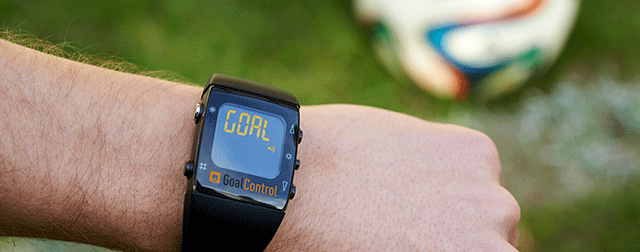It’s time for the World Cup and we are getting excited putting on our team’s jerseys. Only very few people will have the chance to experience this amazing month of matches live in Brazil. But thanks to wearable technologies it is now possible to feel and breath the atmosphere as if you were right there! How this is possible?
With the Alert Shirt from Wearable Experiments (We:eX). We:eX has developed a shirt that allows you to feel what the players feel. The company weaves hardware, software and apparel design seamlessly together with real-time sports data, which is transmitted via a Bluetooth smartphone app to the electronics within the jersey. The Alert Shirt then converts the data into powerful sensations that simulate live sports action. For more details on the project check our interview with Ben Moir from We:eX.
But that’s not the only soccer related wearable on the market. Goal Control is a German company that will put an end to blown calls. The Goal Control-4D system works with 14 high-speed cameras (7 per goal) around the pitch at the stadium roof/catwalk. The cameras are connected to a powerful image processing computer system which tracks the movement of all objects on the pitch and filters out the players, referees and all disturbing objects. The remaining object is the ball and the system knows its three dimensional x-, y- and z-position with a precision of a few millimeters in the coordinate system of the pitch. When the ball passes the goal line, the system sends a vibration- and optical signal to the officials´ smartwatches. All footages of such a goal event, and also of all near-goal events, are stored and can be replayed anytime. For the first time referees will use this technology at all 12 venues in Brazil at the FIFA World Cup 2014 to make sure everything runs smoothly.
Another event happening at the World Cup will be a paralyzed volunteer from the Association for Assistance to Disabled Children walking onto the field opening the tournament with a ceremonial kick on June 12. This miracle will be possible with a robotic exoskeleton that will move the wearer limbs, taking commands directly from his or her thoughts. This demonstration is the debut of the Walk Again Project, a consortium of more than 150 scientists and engineers who have come together to show off recent advances in the field of brain machine interfaces. The paralyzed person will be wearing an electroencephalographic (EEG) headset that records brainwave activity. A backpack computer will translate those electrical signals into commands the exoskeleton can understand. As the robotic frame moves, it also sends its own signals back to the body, restoring not just the ability to walk, but the sensation as well.
Adidas wants soccer players to be fully equipped with their smart products. Their line of sporting gear called, miCoach includes, a smart football with motion sensors that track a ton of data and send it right to an iOS device to help players to improve certain skills during training. There is also a similarly sensor-laden smart shoe providing even more info, such as speed, rotation, distance and direction. If that wasn’t enough adidas recently launched mi Coach X cell, its latest innovation in digital training technology and a device to provide athletes with a complete system to evaluate, train and improve jump height, cut quickness and reaction time. It captures real-time performance metrics in order to provide elite, professional-level training and coaching tips to help athletes improve their game. Stay tuned! Adidas Vice President Adidas Digital Sports Paul Gaudio will be holding a keynote at our Wearable Technologies Conference in San Francisco and presenting the miCoach latest innovation.
To improve the soccer player’s skills Kinexon analyzes and measures athlete and team performance, fitness and tactical behavior during matches and training sessions. Kinexon ONE offers the right training exercises to achieve certain goals. An integrated library offers various exercises that have been developed and recommended by leading sports scientists, coaches and sport associations to make sure the players reach their full potential. It also monitors health indicators to optimize training intensity, reduce injuries, and increase well-being such as the training load and fatigue of your athletes. In case of overload the athlete receives immediate alerts on a tablet. It also supports the rehabilitation process through adequate work load limits after injuries.
Australian-based sports technology company, Catapult offers a technology to measure athlete analytics. The company supports famous soccer clubs like the Italian AC Milan or the German Hannover 96. Their comprehensive solution for the world game is a GNSS-enabled monitor to increase data accuracy, a wireless local positioning system to capture movement inside and out, and IMA for micro-movement metrics. Catapult combines a ball-tracking technology with GPS trackers worn by players to produce a two-dimensional model of how the players and the ball move on the field. There are two benefits to this. First, the player-worn devices send data to the sidelines, allowing trainers to determine who is working at peak levels, who is tiring and how changes in ball possession could be affecting their levels of effort. It expands the benefits of data-tracking from health monitoring and to in-game strategy and analysis. The technology can track who’s had the ball and for how long, where it is on the field, how it got there and at what speed. By examining real-time data, coaches can see where their formations and plays work and where there are weak spots. This will allow changing tactics during the game and in practice sessions.
We look forward to spotting all these wearable technologies at the exciting matches throughout the coming weeks. And don’t forget about our other World Cup: The WT Innovation World Cup just kicked off a few days ago. For more information and free registration click here.
P.S.: Sorry for the spoiler but: Spain will win the World Cup!!!












